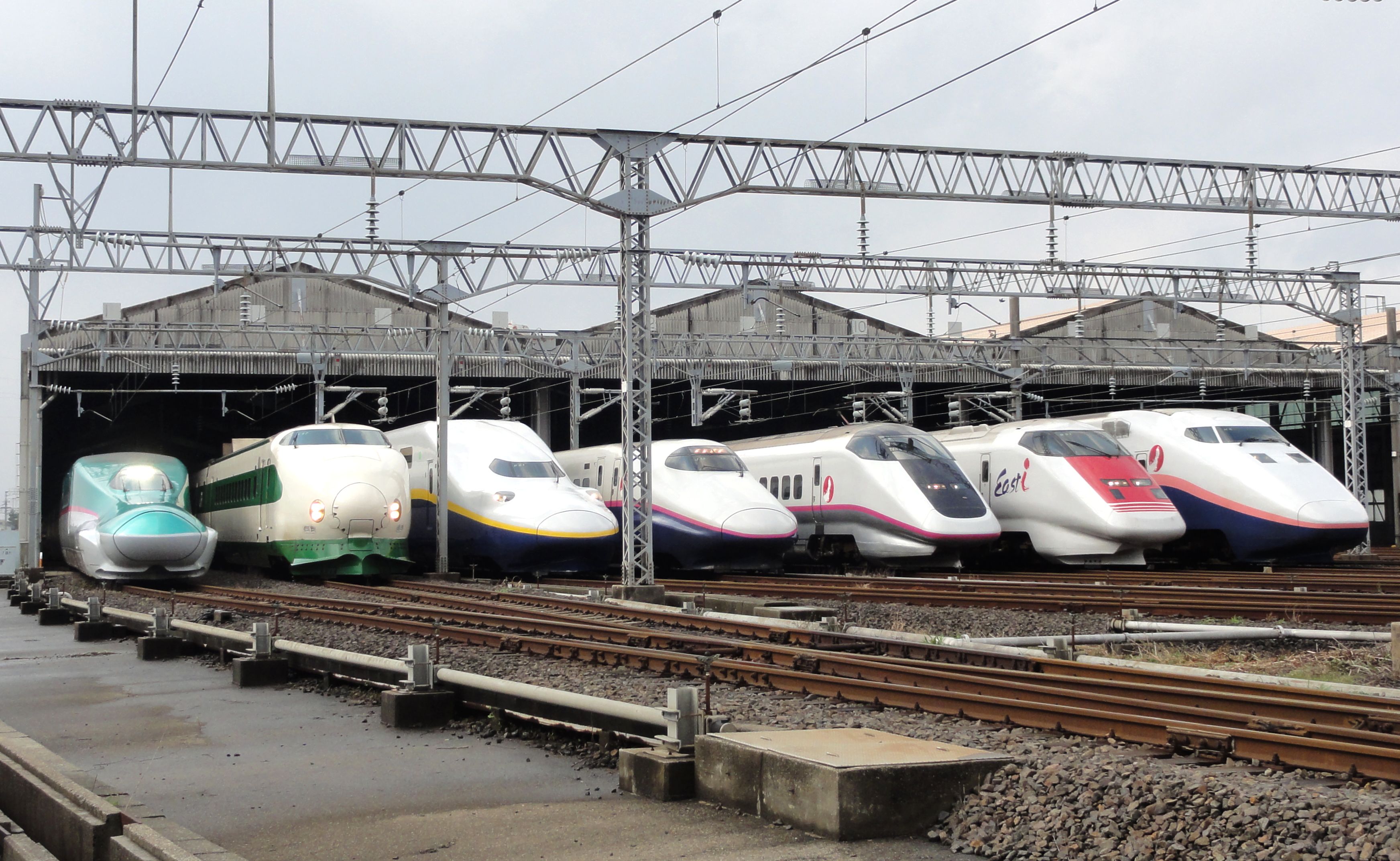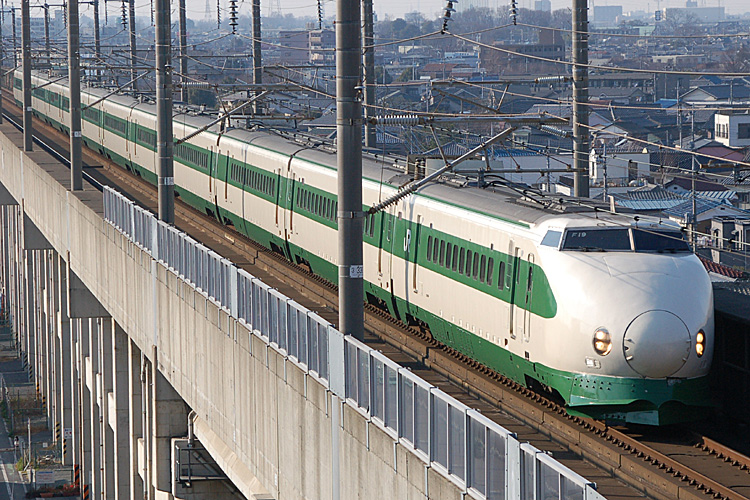|
Class E926 Shinkansen
The also known as the East-i, is a high-speed diagnostic train used on JR East's Shinkansen lines. Entering service in 2001, it is based on the E3 series and carries out line inspections at a maximum speed of . It operates on the Jōetsu Shinkansen, the Tōhoku Shinkansen as well as its two mini-shinkansen branch lines, the Yamagata Shinkansen and Akita Shinkansen; the train also operates on the Hokkaido Shinkansen, owned by JR Hokkaido, as well as sections of the Hokuriku Shinkansen owned by JR West. Similar types of diagnostic trains called Doctor Yellow operate on the Tokaido Shinkansen and San'yo Shinkansen. Overview The Class E926 is a non-revenue earning diagnostic train designed to replace the aging Class 925 inspection train. The Class 925, based on the 200 series, had a lower top speed than newly introduced trainsets at the time, such as the E3 series. Its loading gauge was also incompatible with the mini-shinkansen, which used narrower trains. At the time, the mi ... [...More Info...] [...Related Items...] OR: [Wikipedia] [Google] [Baidu] |
Tokyu Car Corporation
is a manufacturer of heavy rail cars in Japan, formerly known as . The company is based in Kanazawa-ku, Yokohama, and a member of East Japan Railway Company (JR East) group. J-TREC manufactures rail vehicles not only for JR East and Tokyu Corporation but for other Japanese operators, including various Japan Railways Group companies and international operators as well. Tokyu Car Corporation, the predecessor of J-TREC, was founded on 23 August 1948. Tokyu Car was a licensee of early-generation (early-1960s) stainless-steel commuter EMU train body and related bogie technology from the Budd Company of the United States. Since then, Tokyu Car has specialised in stainless-steel body car technology. On 27 October 2011, Tokyu Car Corporation announced that its rolling stock manufacturing division would be acquired by East Japan Railway Company (JR East), and the company cease operations with effect from 1 April 2012. It is to be subsequently split into two companies, Tokyu Car Engineer ... [...More Info...] [...Related Items...] OR: [Wikipedia] [Google] [Baidu] |
JR West
, also referred to as , is one of the Japan Railways Group (JR Group) companies and operates in western Honshu. It has its headquarters in Kita-ku, Osaka. It is listed in the Tokyo Stock Exchange, is a constituent of the TOPIX Large70 index, and is also one of only three Japan Railways Group constituents of the Nikkei 225 index: the others are East Japan Railway Company, JR East and Central Japan Railway Company, JR Central. It was also listed in the Nagoya Stock Exchange, Nagoya and Fukuoka Stock Exchange, Fukuoka stock exchanges until late 2020. Lines Shinkansen * Hokuriku Shinkansen ( - ) * San'yō Shinkansen * Hakata Minami Line :: Officially not a Shinkansen JR-West's highest-grossing line is the Sanyo Shinkansen high-speed rail line between Osaka and Fukuoka, Fukuoka, Fukuoka. The Sanyo Shinkansen alone accounts for about 40% of JR-West's passenger revenues. The company also operates Hakata Minami Line, a short commuter line with Shinkansen trains in Fukuoka, Fuku ... [...More Info...] [...Related Items...] OR: [Wikipedia] [Google] [Baidu] |
Tokyu Car Multiple Units
The , a contraction of and formerly until 2 September 2019, is a Japanese ''keiretsu'' or conglomerate (company), conglomerate headquartered in Shibuya, Tokyo. While a multinational corporation, its main operation is , a wholly-owned subsidiary operating railways in the Greater Tokyo Area. History The oldest predecessor of company was the , opened in 1908. The railway's operations were converted into a kabushiki gaisha (company) in 1910. Keita Gotō (industrialist), Keita Gotō, now a notable Japanese industrialist, was appointed as the CEO in 1920 and he began a major expansion program. The most important predecessor was first registered on September 2, 1922, as the and is related to the construction of Den-en-chōfu. It was originally founded by the developers of Den-en-chōfu). It was acquired by the Musashi Electric Railway in 1924, shortly before Musashi was renamed into the , also known as the Toyoko, in the same year. After Musashi/Toyoko's acquisition, the Me ... [...More Info...] [...Related Items...] OR: [Wikipedia] [Google] [Baidu] |
East Japan Railway Company
The is a major passenger railway company in Japan and the largest of the seven Japan Railways Group companies. The company name is officially abbreviated as JR-EAST or JR East in English, and as in Japanese. The company's headquarters are in Yoyogi, Shibuya, Tokyo, next to Shinjuku Station. It is listed in the Tokyo Stock Exchange (it formerly had secondary listings in the Nagoya and Osaka stock exchanges), is a constituent of the TOPIX Large70 index, and is one of three Japan Railways Group constituents of the Nikkei 225 index, the others being JR Central and JR West. History JR East was incorporated on 1 April 1987 after being spun off from the government-run Japanese National Railways (JNR). The spin-off was nominally "privatization", as the company was actually a wholly owned subsidiary of the government-owned JNR Settlement Corporation for several years, and was not completely sold to the public until 2002. Following the breakup, JR East ran the operations on forme ... [...More Info...] [...Related Items...] OR: [Wikipedia] [Google] [Baidu] |
Shinkansen Train Series
The , colloquially known in English as the bullet train, is a network of high-speed railway lines in Japan. It was initially built to connect distant Japanese regions with Tokyo, the capital, to aid economic growth and development. Beyond long-distance travel, some sections around the largest metropolitan areas are used as a commuter rail network. It is owned by the Japan Railway Construction, Transport and Technology Agency and operated by five Japan Railways Group companies. Starting with the Tokaido Shinkansen () in 1964, the network has expanded to consist of of lines with maximum speeds of , of Mini-shinkansen lines with a maximum speed of , and of spur lines with Shinkansen services. The network links most major cities on the islands of Honshu and Kyushu, and connects to Hakodate on the northern island of Hokkaido. An extension to Sapporo is under construction and was initially scheduled to open by fiscal year 2030, but in December 2024, it was delayed until the end ... [...More Info...] [...Related Items...] OR: [Wikipedia] [Google] [Baidu] |
Electric Multiple Units Of Japan
Electricity is the set of physical phenomena associated with the presence and motion of matter possessing an electric charge. Electricity is related to magnetism, both being part of the phenomenon of electromagnetism, as described by Maxwell's equations. Common phenomena are related to electricity, including lightning, static electricity, electric heating, electric discharges and many others. The presence of either a positive or negative electric charge produces an electric field. The motion of electric charges is an electric current and produces a magnetic field. In most applications, Coulomb's law determines the force acting on an electric charge. Electric potential is the work done to move an electric charge from one point to another within an electric field, typically measured in volts. Electricity plays a central role in many modern technologies, serving in electric power where electric current is used to energise equipment, and in electronics dealing with electrical ... [...More Info...] [...Related Items...] OR: [Wikipedia] [Google] [Baidu] |
Catenary
In physics and geometry, a catenary ( , ) is the curve that an idealized hanging chain or wire rope, cable assumes under its own weight when supported only at its ends in a uniform gravitational field. The catenary curve has a U-like shape, superficially similar in appearance to a parabola, which it is not. The curve appears in the design of certain types of Catenary arch, arches and as a cross section of the catenoid—the shape assumed by a soap film bounded by two parallel circular rings. The catenary is also called the alysoid, chainette,#MathWorld, MathWorld or, particularly in the materials sciences, an example of a funicular curve, funicular. Rope statics describes catenaries in a classic statics problem involving a hanging rope. Mathematically, the catenary curve is the Graph of a function, graph of the hyperbolic cosine function. The surface of revolution of the catenary curve, the catenoid, is a minimal surface, specifically a minimal surface of revolution. A ha ... [...More Info...] [...Related Items...] OR: [Wikipedia] [Google] [Baidu] |
E2 Series Shinkansen
The is a Japanese high-speed Shinkansen train type operated by East Japan Railway Company (JR East) on the Tohoku Shinkansen high-speed lines in Japan since 1997. They are formed in 8- and 10-car sets. The 8-car sets were used on the Hokuriku Shinkansen, and the 10-car sets are on Tohoku Shinkansen services. The 10-car sets can be coupled to E3 series sets using couplers hidden behind retracting nose doors. They operate at a maximum speed of on the Tohoku Shinkansen. A total of 502 vehicles (14 8-car "N" sets and 39 10-car "J" sets) were built between 1997 and 2010, with the first withdrawals commencing in late 2013. Operations Tohoku Shinkansen * '' Yamabiko'' * '' Nasuno'' Past operations Tohoku Shinkansen * Hayate (1 December 2002 - 16 March 2019) Hokuriku Shinkansen * '' Asama'' (1 October 1997 - 31 March 2017) Joetsu Shinkansen * ''Asahi'' * '' Toki'' * '' Tanigawa'' Variants * E2 series 8-car "N" sets * E2' series 10-car "J" sets * E2-1000 series 10-car ... [...More Info...] [...Related Items...] OR: [Wikipedia] [Google] [Baidu] |
200 Series Shinkansen
The was a Shinkansen high-speed train type introduced by Japanese National Railways (JNR) for the Tohoku Shinkansen and Joetsu Shinkansen high-speed rail lines in Japan, and operated by East Japan Railway Company (JR East) until 2013. They actually predated the 100 Series Shinkansen, 100 series trains, having been built between 1980 and 1986. It was one of the two recipients of the 23rd Laurel Prize presented by the Japan Railfan Club, the first Shinkansen type to receive that award. The last remaining sets were retired from regular service in March 2013, and were completely withdrawn from service in April 2013. Design The 200 Series Shinkansen trains resembled the earlier 0 Series Shinkansen, 0 series trains in styling (some later units had the pointed 'shark nose' of the 100 series), but were lighter and more powerful, since these two lines are mountain routes and have steeper gradients. These lines are also prone to snowfall and the trains had small snowplows fitted, as well ... [...More Info...] [...Related Items...] OR: [Wikipedia] [Google] [Baidu] |



